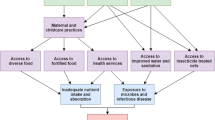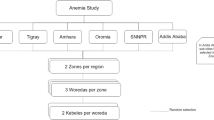Abstract
Anemia is a public health problem in Mexico. This study sought to determine the prevalence and correlates of anemia among women and children residing in a rural farming region of Baja California, Mexico. An existing partnership between universities, non-governmental organizations, and an underserved Mexican community was utilized to perform cross-sectional data collection in 2004–2005 (Wave 1) and in 2011–2012 (Wave 2) among women (15–49 years) and their children (6–59 months). All participants completed a survey and underwent anemia testing. Blood smears were obtained to identify etiology. Nutrition education interventions and clinical health evaluations were offered between waves. Participants included 201 women and 99 children in Wave 1, and 146 women and 77 children in Wave 2. Prevalence of anemia significantly decreased from 42.3 to 23.3 % between Waves 1 and 2 in women (p < 0.001), from 46.5 to 30.2 % in children 24–59 months (p = 0.066), and from 71.4 to 45.8 % in children 6–23 months (p = 0.061). Among women in Wave 1, consumption of iron absorption enhancing foods (green vegetables and fruits high in vitamin C) was protective against anemia (p = 0.043). Women in Wave 2 who ate ≥4 servings of green, leafy vegetables per week were less likely to be anemic (p = 0.034). Microscopic examination of blood smears revealed microcytic, hypochromic red blood cells in 90 % of anemic children and 68.8 % of anemic women, consistent with iron deficiency anemia.
Similar content being viewed by others
References
World Health Organization (WHO). (2008). Worldwide Prevalence of Anemia 1993–2005: WHO Global database on Anemia. Geneva: World Health Organization. Retrieved from http://whqlibdoc.who.int/publications/2008/9789241596657_eng.pdf.
Yip, R., & Ramakrishnan, U. (2002). Experiences and challenges in developing countries. The Journal of Nutrition, 132(4 Suppl), 827S–830S.
World Health Organization (WHO) & United Nations Children’s Fund (UNICEF). (2004). Focusing on anaemia: A joint statement by WHO and UNICEF. Geneva: World Health Organization. Retrieved from http://www.who.int/nutrition/publications/micronutrients/WHOandUNICEF_statement_anaemia/en/.
Gutierrez, J. P., Rivera-Dommarco, J., Shamah-Levy, T., Villalpando-Hernández, S., Franco, A., Cuevas-Nasu, L., & Hernandez-Avila, M. (2012). Encuesta Nacional de Salud y Nutrición 2012. Resultados Nacionales. Cuernavaca: Instituto Nacional de Salud Pública.
Shamah-Levy, T., Villalpando, S., Mundo-Rosas, V., la Cruz-Góngora, V. D., Mejía-Rodríguez, F., & Méndez Gómez-Humarán, I. (2013). Prevalence of anemia in reproductive-age Mexican women. Salud pública de México, 55(Suppl 2), S190–S198.
De la Cruz-Góngora, V., Villalpando, S., Rebollar, R., Shamah-Levy, T., & Méndez-Gómez Humarán, I. (2012). Nutritional causes of anemia in Mexican children under 5 years. Results from the 2006 National Health and Nutrition Survey. Salud pública de México, 54(2), 108–115.
Villalpando, S., Shamah-Levy, T., García-Guerra, A., Mundo-Rosas, V., Domínguez, C., & Mejía-Rodríguez, F. (2009). The prevalence of anemia decreased in Mexican preschool and school-age children from 1999 to 2006. Salud pública de México, 51(Suppl 4), S507–S514.
Rivera, J. A., Monterrubio, E. A., González-Cossío, T., García-Feregrino, R., García-Guerra, A., & Sepúlveda-Amor, J. (2003). Nutritional status of indigenous children younger than five years of age in Mexico: Results of a national probabilistic survey. Salud pública de México, 45(Suppl 4), S466–S476.
Shamah-Levy, T., Villalpando, S., Rivera, J. A., Mejía-Rodríguez, F., Camacho-Cisneros, M., & Monterrubio, E. A. (2003). Anemia in Mexican women: A public health problem. Salud pública de México, 45(Suppl 4), S499–S507.
Bothwell, T. H., Baynes, R. D., MacFarlane, B. J., & MacPhail, A. P. (1989). Nutritional iron requirements and food iron absorption. Journal of Internal Medicine, 226(5), 357–365.
Romieu, I., Palazuelos, E., Hernandez Avila, M., Rios, C., Muñoz, I., Jimenez, C., & Cahero, G. (1994). Sources of lead exposure in Mexico City. Environmental Health Perspectives, 102(4), 384–389.
Villalobos, M., Merino-Sánchez, C., Hall, C., Grieshop, J., Gutiérrez-Ruiz, M. E., & Handley, M. A. (2009). Lead (II) detection and contamination routes in environmental sources, cookware and home-prepared foods from Zimatlán, Oaxaca, Mexico. The Science of the Total Environment, 407(8), 2836–2844. doi:10.1016/j.scitotenv.2008.12.059.
Zabin, C., & Hughes, S. (1995). Economic integration and labor flows: Stage migration in farm labor markets in Mexico and the United States. The International Migration Review, 29(2), 395–422.
Rosales, C., Ortega, M. I., De Zapien, J. G., Paniagua, A. D. C., Zapien, A., Ingram, M., & Aranda, P. (2012). The US/Mexico border: A binational approach to framing challenges and constructing solutions for improving farmworkers’ lives. International Journal of Environmental Research and Public Health, 9(6), 2159–2174. doi:10.3390/ijerph9062159.
Leyva-Flores, R., Infante-Xibille, C., Gutiérrez, J. P., & Quintino-Pérez, F. (2013). Persisting health and health access inequalities in Mexican indigenous population, 2006–2012. Salud Pública De México, 55(Suppl 2), S123–S128.
Secretaría de Desarrollo Social (SEDESOL). (n.d.). Catálogo de Localidades. Retrieved from http://www.microrregiones.gob.mx/catloc/LocdeMun.aspx?tipo=clave&campo=loc&ent=02&mun=001.
World Health Organization (WHO). (2011). Haemoglobin concentrations for the diagnosis of anaemia and assessment of severity. Vitamin and Mineral Nutrition Information System. Geneva: World Health Organization. Retrieved from http://www.who.int/vmnis/indicators/haemoglobin.pdf.
Shamah-Levy, T., Villalpando-Hernández, S., García-Guerra, A., Mundo-Rosas, V., Mejía-Rodríguez, F., & Domínguez-Islas, C. P. (2009). Anemia in Mexican women: Results of two national probabilistic surveys. Salud Pública De México, 51(Suppl 4), S515–S522.
Backstrand, J. R., Allen, L. H., Black, A. K., de Mata, M., & Pelto, G. H. (2002). Diet and iron status of nonpregnant women in rural Central Mexico. The American Journal of Clinical Nutrition, 76(1), 156–164.
Centers for Disease Control and Prevention (CDC). (1998). Recommendations to prevent and control iron deficiency in the United States. MMWR, 47(RR-3), 1–29.
Lansdown, R. G., Clayton, B. E., Graham, P. J., Shepherd, J., Delves, H. T., Turner, W. C., & Jeffs, S. G. (1974). Blood-lead levels, behaviour, and intelligence a population study. The Lancet, 303(7857), 538–541. doi:10.1016/S0140-6736(74)92718-4.
Landrigan, P. J., & Todd, A. C. (1994). Lead poisoning. Western Journal of Medicine, 161(2), 153–159.
Feldman, R. G., Hayes, M. K., Younes, R., & Aldrich, F. D. (1977). Lead neuropathy in adults and children. Archives of Neurology, 34(8), 481–488.
Lynch, R., Elledge, B., & Peters, C. (2008). An assessment of lead leachability from lead-glazed ceramic cooking vessels. Journal of Environmental Health, 70, 36–40, 53.
Camarena Ojinaga, L., von Glascoe, C., Martínez Valdés, C., & Arellano García, E. (2013). Occupational risks and health: Perceptions of indigenous female agricultural workers in Northwestern Mexico. Salud Colectiva, 9(2), 247–256. doi:10.1590/S1851-82652013000200009.
Lopez, M. J., Mintle, R. A., Smith, S., Garcia, A., Torres, V. N., Keough, A., & Salgado, H. (2014). Risk factors for intimate partner violence in a migrant farmworker community in Baja California, México. Journal of Immigrant and Minority Health/Center for Minority Public Health. doi:10.1007/s10903-014-9988-8.
Palacios-Nava, M. E., & Moreno-Tetlacuilo, L. M. A. (2004). Health differences between male and female migrant agricultural workers in Sinaloa, Mexico. Salud pública de México, 46(4), 286–293.
Martínez-Valenzuela, C., Gómez-Arroyo, S., Villalobos-Pietrini, R., Waliszewski, S., Calderón-Segura, M. E., Félix-Gastélum, R., & Alvarez-Torres, A. (2009). Genotoxic biomonitoring of agricultural workers exposed to pesticides in the north of Sinaloa State, Mexico. Environment International, 35(8), 1155–1159. doi:10.1016/j.envint.2009.07.010.
Mexico | Office of the United States Trade Representative. Retrieved from http://www.ustr.gov/countries-regions/americas/mexico.
Cifuentes, E., Mazari-Hiriart, M., Carneiro, F., Bianchi, F., & Gonzalez, D. (2002). The risk of enteric diseases in young children and environmental indicators in sentinel areas of Mexico City. International Journal of Environmental Health Research, 12(1), 53–62. doi:10.1080/09603120120110059.
Acknowledgments
The authors wish to thank the VIIDAI faculty, students, and staff for their assistance in conducting this study.
Author information
Authors and Affiliations
Corresponding author
Rights and permissions
About this article
Cite this article
Moor, M.A., Fraga, M.A., Garfein, R.S. et al. Decreased Anemia Prevalence Among Women and Children in Rural Baja California, Mexico: A 6-Year Comparative Study. J Community Health 41, 780–789 (2016). https://doi.org/10.1007/s10900-016-0153-2
Published:
Issue Date:
DOI: https://doi.org/10.1007/s10900-016-0153-2




